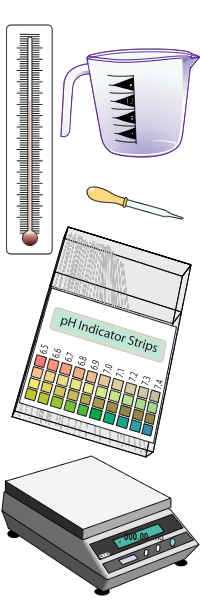AN1.1. Investigation: Create Your Own Ecosystem

Life has adapted to many different kinds of environments. There are tiny plants and animals that live on frozen glaciers. Giant tube worms and other strange plants and animals live deep in the ocean, where no sunlight penetrates, but where volcanic vents provide energy and nutrients. These vastly different forms of life and environments are some of the many ecosystems that can be found on Planet Earth.
One way to study an ecosystem is to create your own—a world in a bottle. Your laboratory ecosystem will not be a perfect replica of what occurs in nature because important parts of a natural system are left out, but it will enable you to perform experiments and gain insights into how natural ecosystems function.
In this activity you will work with partners to create two ecosystems. Decide together all the things that will be the same in both ecosystems. Then decide what the one thing—called the test variable—that will be different about one of the ecosystems. If the two ecosystems start out the same, any difference between them can then be attributed to the test variable. This is called a controlled experiment.
Try to maintain your ecosystem until the end of the unit. In the last chapter is a series of questions about your ecosystem experiment, and how it relates to the larger issues presented in this guide. Whether or not you succeed in creating a sustainable living system will not be as important as what you learn from the experience of trying; and how you apply that experience to the real-world issues of global environmental change.
Materials for Your Experiment

- two clear containers that will hold water (0.5 gallon to 2 gallons)
- a source of pond water or dechlorinated tap water
- aquarium-ready gravel or sand
- light source (You can use incandescent or fluorescent light.)
- measuring cups and metric scales (accurate to .01 gram)
- small pipette or medicine dropper
- pH indicator kit
- ammonia test kit
- thermometer
- a timer for controlling the period of light
- graph paper
- Living organisms (make your selection)
- aquatic plants such as elodea or anacharis
- several small snails or other aquatic plant eaters such as daphnia
- scavengers such as tubifex worms or planaria
- pond water microorganisms
Setting Up Your Experiment
1. Plan. Decide what plants and animals to keep in your aquatic ecosystem, and what you might select as a test variable.
2. Water. Obtain pond water or dechlorinated water.
3. Gravel. Place the same amount of aquarium-ready gravel or sand on the bottom of each container.
4. Water Depth. Think about the relationship between the surface area of the water and the water depth. Oxygen enters the water through the surface. Will organisms on the bottom have an adequate supply of oxygen? How deep do you think the water in the containers should be?
5. Water Level. Pour in the water. Mark the water level with a felt marker or piece of tape.
6. Plants and Animals. Place the plants and animals carefully into each container.
7. Temperature. As water warms up, it contains less oxygen. Keep your experiment in a cool environment out of direct sunlight so that it holds enough oxygen for animals in the water to “breathe.”
Conducting Your Experiment
1. Log. Start your log as soon as possible. It can be in the form of a spiral notebook, or loose leaf pages in a notebook. Each entry should be dated and signed. The first entry should carefully describe both ecosystems, noting the number and quantity of both the living and nonliving components.
2. Hypothesis. Form a hypothesis—a reasoned guess about how you think the plants and animals will be affected by the test variable. Predict what will occur in the two ecosystems if your hypothesis is correct. Write your hypothesis in your log.
3. Baseline. Begin by keeping both containers the same for two or three days, to see if they are developing in the same way. Put letters or names on the two ecosystems so you can refer to them in your log.
4. Regular Observations. Spend 10-15 minutes each day observing and recording events in the two ecosystems. What colors are the plants? What activities and/or interactions do you observe among the animals? Note any differences you see in the two systems. Write down your observations, even if you observe no changes. By the end of the first week you should have a checklist of things to observe in each ecosystem.
5. Test Variable. After two or three days, prepare to test your hypothesis. Make one of the ecosystems different from the other. You may add something, take something away, move one ecosystem to a different place, or so on
6. Keep All Other Variables the Same. Avoid making any other changes to the two containers. However, if you must change one container, do the same to the other container. For example, if you add water to one of the containers because the level is getting low, you must add water to the other container so it reaches the same level. That way, any differences between the two ecosystems can be attributed to the single test variable.
7. Record New Questions. As you observe your ecosystems, new questions are bound to arise. You may wonder why an animal acts the way it does, or why the plants turn color, or what if the water were deeper or shallower. Write down these thoughts and questions in your log, even if you do not have the opportunity to pursue them at this time.
8. Preliminary Findings. In the last chapter you will be asked to reflect on this experiment and draw conclusions. Meanwhile, if you start to notice differences between the two containers, and have some preliminary conclusions, write these down in your log.


